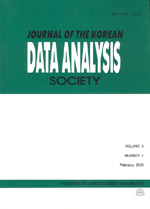한국교육종단연구 데이터에 대한 위계적 선형모형의 적용
Application of Hierarchical Linear Model(HLM) on the Korean Educational Longitudinal Study Data
- 한국자료분석학회
- Journal of The Korean Data Analysis Society (JKDAS)
- Vol.13 No.2
-
2011.04833 - 843 (11 pages)
- 이용수 69

초록
그룹 내에 조사단위가 위계적 구조를 형성하고 있는 자료는 오차항 사이에 상관관계가 존재하게 되며 상위수준에 따른 상수항 및 회귀계수 값이 층마다 차이를 보이게 된다. 그러나 이러한 자료의 특성을 무시하고 통상적인 최소제곱법(OLS: ordinary least square)을 적용하여 분석을 실시한 경우가 흔히 있다. 층을 가지고 있는 자료에서 일반적인 최소제곱법을 적용하여 분석하면 연구의 타당성이 결여되기 쉽고, 추정의 정밀도(precision)가 떨어지게 된다. 본 논문에서는 자료가 위계적 구조를 가지고 얻어진 경우 그러한 특성을 반영하여 자료를 분석하는 위계적 선형모형(HLM: hierarchical linear model)의 특징과 내용을 살펴보고자 한다. 또한 한국교육종단연구 데이터에 대한 사례분석을 통하여 최소제곱법의 결과와 비교하여 유용성 및 효율성을 파악한다.
The fundamental concerns of the paper discusses character and structure of the hierarchical linear model (HLM) though Korean Educational Longitudinal Study data that are from a real educational and social research. When the data are collected with hierarchical structure that have two-level variable (or three-level variable), frequently incorrect results and conclusions are derived because appropriate statistical models are not considered. In this paper, in order to see that the hierarchical linear model derive appropriate results via the general linear model in the case of hierarchical structured date, the hierarchical linear model and the general linear model (linear regression) are applied on real data. Then, the results of two methods are compared with some remarks.
목차
1. 서론
2. 위계적 선형모형의 소개
3. 사례 연구
4. 결론 및 토의
참고문헌
참고문헌 (0)
등록된 참고문헌 정보가 없습니다.
해당 권호 수록 논문 (45)
- A Comparison of Numerical Stability of PLS1 Algorithms
- The Import Demand for Fresh Raspberries and Well-being Diet Trends in Hotel and Restaurant Industry
- Enactment of Restriction on Cross-Shareholding and Managerial Reactions
- TV시청률 예측을 위한 변동성 연구
- 절사와 가중치를 이용한 향상된 배깅 알고리즘에 대한 연구
- 학령기 아토피 피부염 아동을 위한 건강증진교육 프로그램의 효과
- 청소년직장체험프로그램 참여자의 임금효과 분석
- 전문대학 졸업반 학생들의 취업스트레스와 신체건강 및 정신건강에 관한 연구
- 북한이탈주민의 외상 후 스트레스와 사회적응의 관계에서 자아존중감의 매개효과 및 조절효과 검증
- 자기성장훈련 프로그램이 간호사의 자기효능감과 우울에 미치는 효과
- 마산만 유입 하천 수질 장기모니터링 자료의 통계분석
- 현금흐름과 연구개발투자
- Does Consumer Sentiment Forecast Household Consumption? Evidence from Korean Household Data
- The Gold Futures in the Korean Market
- 초등학생의 신체상 인식에 따른 자기표현 및 대인관계의 특성
- 고령자 직업훈련의 훈련만족도에 관한 조사
- 준비모수 모형을 이용한 원/달러, 엔/달러 환율의 동태적 분석
- 스마트폰 사용에 따른 정보 민감성의 차이
- 직업군별 직업적응에 관한 연구
- 임상간호사의 조직몰입에 영향을 미치는 요인
- 재가 노인의 신체기능과 우울 간 관계에서 수면의 질의 매개 작용
- 연관성 규칙 탐사에서의 대칭적 순수 신뢰도의 제안
- 사이버 안전 지수 측정을 위한 개인 부분 표본설계
- 경제적 의존도와 감사품질의 관련성
- 경도인지장애와 알츠하이머 치매 여성노인의 하지운동기능 비교
- 유전자-유전자간 상호작용 분석을 위한 분류기법
- Hierarchical Bayesian Model for Small Area Estimation of Poisson Means
- 사별노인이 지각한 건강상태에 영향을 미치는 요인
- Validity and Reliability of the Quality of Life Section in Minimum Data Set 3.0 for Nursing Home Residents (Psychometrics of MDS 3.0)
- 주가변동성의 예측성과 비교
- 발생액 변화에 대한 영업현금흐름 변화의 비대칭성과 그 결정요인
- 지하철 역세권 상업업무시설의 입지특성에 관한 연구
- 경기변화와 은행의 대출행태 연구
- 한국교육종단연구 데이터에 대한 위계적 선형모형의 적용
- The Effect of Tobacco Price and Anti-Smoking Policy Budgets on Smoking Prevalence in Korea
- Fama-French의 3요인 모형을 이용한 아파트 수익률 결정요인 분석
- 금융신상품의 소비자 수용에 관한 연구
- 이용자 측면에서 본 도심지역의 가로시설물 개선방안
- 2단계 혼합 확률화응답모형
- 전문선수 팀 지도자의 전지훈련 환경 만족도가 재방문에 미치는 영향
- 주유소 환경특성이 주유 고객의 평가와 충성도에 미치는 영향
- m-러닝 재사용 의도에 관한 실증분석
- 초고속 무선인터넷에서 인구통계적 요인이 폰형과 모뎀형 선택에 끼치는 영향에 관한 연구
- 한국 성인여성들의 우울증과 자살생각에 대한 분석
- Bayesian Regime-switching Analysis via Stochastic Approximation Monte Carlo